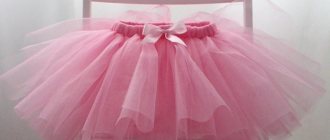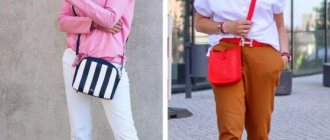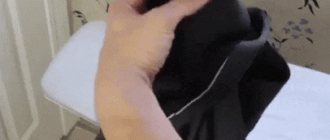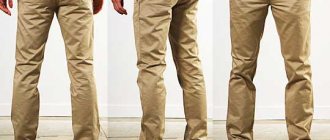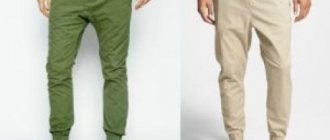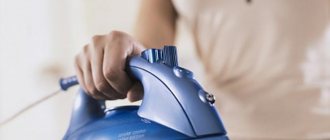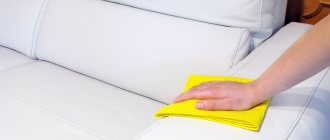Classic trousers with arrows must look perfect. Any error is immediately noticeable, unlike bananas, jeans or cargo, which have a more casual style. The overall look depends on the quality of the ironed trousers. Trousers with creases are part of a business look, and the look will be hopelessly ruined by unkempt trousers or unevenly ironed creases.
The history of the appearance of arrows on trousers
Arrows on trousers appeared relatively recently, when compared with the age of the type of clothing itself. At the end of the 19th century, a dramatic breakthrough in the textile and clothing industry in Europe gave rise to massive exports of garments, including trousers, to America. The clothes were transported quite roughly - they were pressed and then compacted into the holds, stuffing them “to capacity.” As a result, the clothes, and of course the trousers, received such creases that even the ironed trousers remained with creases.
The American nation was experiencing a rapid influx of immigrants, the massive development of new lands, the Civil War was brewing, and did not make any special claims to clothing. The men wore trousers with creases, as they had bought them, and were not too worried about it - there were more important problems. After some time, such a defect became familiar and gradually became fashionable.
Let's reveal the secrets of impeccable trousers
Trousers with creases as sharp as a razor blade indicate the organization and neatness of their owner. Therefore, the question of how to achieve clear lines after washing worries many of our citizens.
Who invented the arrows? About 2 centuries ago, this item of clothing began to be sewn in large quantities, then sent to the consumer. The trousers had to be laid in such a way that caked folds remained.
The gentlemen, and then the ladies, did not smooth them out, but walked around as they were. Straight lines indicated that this thing was new, and its owner lived in abundance. Then it became so fashionable that we still wear this wardrobe item with arrows.
Differences between men's and women's trousers
The blurring of the line between women's clothing and men's clothing sometimes makes it difficult to determine the purpose of trousers based on gender. Apart from outright unisex, where there really is no difference, the difference can be determined by several nuances. Whatever the color of the fabric, its structure and weaving, the clear difference between women's and men's trousers lies in the belt and fastener. The belt on men's trousers is sewn with a large number of belt loops - from 8 to 10 pieces. This helps to keep the product on the almost non-existent male waist, especially with narrow hips. Women's hips are noticeably wider than the lumbar region, so the trousers fit the wearer perfectly even without the help of a belt - no more than 5 belt loops.
The next difference lies in the cut of the codpiece, the common style of the fly. The first thing you need to pay attention to is the direction of the fastener. On men's trousers it looks on the right side, on women's trousers - on the left side. The structure of the codpiece can also vary - in the men's version, as a rule, buttons are used, in the women's version there is always a zip fastener (zipper), although men's models are already sewn with a zipper.
The cut of the trouser leg - in the men's version it is straight, in the women's version the side seam can be curved in the shape of a crescent in the hip area, but not always, for example, in “pipes” it is straight.
Arrow location determination
There are cases when the arrows on the back and front of the trousers are incorrectly positioned or an error was made when ironing. In this case, you will need to steam the product on the left side, completely straightening the legs. Only after this procedure is it necessary to outline a new area for processing.
How to properly straighten creases on trousers is a question that worries many people. On a product with a high-quality cut, sewn by a good craftsman, it is enough to match the seams of the right and left trouser legs. The folds will be in the right place for them. There are location features that you should be guided by:
- the fold is located in the middle at the bottom of the panel, front and back, as well as in the knee area;
- you need to make sure that the arrows strive to divide both parts into equal halves;
- in front, the arrows begin on the fold near the belt; if there are two of them, then you should focus on the one closest to the codpiece;
- The fold at the back is at the end of the dart or the inner edge of the pocket.
On women's trousers, all arrows should start from the waistband.
If at least one condition is violated, it is necessary to properly iron the straight creases on the trousers, first securing the set result with binders, pins, or simply basting. Only then iron it. Everything described applies to female and male models.
Modes for different types of fabric
Before ironing your trousers, you need to pay attention to the accompanying label, which must indicate the temperature recommended for ironing, as well as the type of textile. Failure to follow the recommendations may result in the formation of scorch marks or the fabric remaining unironed.
Recommended heating temperature on the iron regulator:
- Silk - 60–80º;
- Viscose - 120º;
- Linen - 180–200º;
- Nylon—60–80º;
- Cotton - 170–180º;
- Wool - 100–120º;
- Knitwear - 90–120º.
If possible, knitwear is not ironed at all, but if necessary, do it only from the inside out, the same way as with velor, velvet, and corduroy. You cannot put strong pressure on any pile fabric - it is impossible to “lift” the ironed pile.
At what temperature should you iron?
Each product has a special label indicating care instructions. To determine the appropriate temperature, you need to find an icon in the form of an iron with a number of dots. The more there are, the more you can warm up the device before ironing. If there is no label, you should focus on the type of fabric:
- natural cotton – 180-220 °C;
- flax – 210-240 °C;
- viscose – 150-180 °C;
- any type of wool – 150-170 °C;
- silk – 140-160 °C;
- polyester – 140-150 °C.
Leather dress pants cannot be ironed; when exposed to high temperatures, the material deteriorates and becomes deformed.
Delicate fabrics such as silk, viscose and jersey should only be ironed on the reverse side at the lowest possible temperature. And it is best to create arrows on woolen products using vertical steaming.
How to iron trousers with arrows
Trousers with arrows require careful care and proper ironing. To do this, the folds need to be ironed using an iron or a steam generator, an ironing iron (gauze, special fabric). If the device does not have a steaming function, then a spray bottle with clean water can successfully replace it.
How to iron classic trousers with arrows
How to iron dress pants correctly? After the small parts of the product have been ironed, the trousers are folded together on the surface, the internal and side seams are aligned, and then the upper trouser leg is folded back. Then carefully and carefully iron the spread part, not forgetting about the wet mode and the iron if there is no overhead sole. Instead of an iron, you can use a steam generator, but the trousers should still be in a horizontal position.
Simple ironing and steaming does not guarantee long-term preservation of shape; on the contrary, the sharpness of the angle on the fold of the fabric is smoothed out quite quickly. To keep the arrow in place, you must use a press. Do not be upset if such a device is not available in the arsenal of home appliances - no one except seamstresses has it. A thick book will perfectly fulfill the role of a press. They do this by following a step-by-step algorithm:
- spread a damp cloth on the canvas and iron it;
- Having removed the iron, immediately place a book volume in its place and hold it for about 30 seconds;
- While the book is lying, iron the next part of the canvas, and then move the book.
In this way, all the arrows will be ironed, and after steaming with the help of an improvised press, they will hold the angle much longer and more clearly. Synthetics do not need steam treatment - the fabric already holds folds perfectly.
How to iron out the top of your trousers
Clean trousers are carefully laid out on the surface of an ironing board or table - it is preferable to use a board. It is necessary to conduct a visual inspection of the product, pay attention to the condition of the seams, pockets, belt loops, bottom hems, and identify places that require special attention:
- If the seams are wrinkled on the wrong side, then they are ironed first - it is advisable that there is some kind of backing between the panels of the trouser leg at this time - this will protect the front side from the imprint of the cuts.
- Then they iron the burlap of the pockets, not forgetting to set the required temperature. Burlap can be made of twill or cotton lining fabric, and different modes are set for them.
- After this, iron the hem at the bottom and turn the product right side out.
Next, the codpiece and belt are ironed, making sure that each part remains in perfect condition. It is most convenient to do this on the tapered end (tongue) of the ironing board - this is one of the most difficult operations, and the back should not touch the front. Trousers are always ironed from top to bottom.
We recommend:
Ironing system with steam generator for home
How to secure folds
There are a couple of techniques that will not only help you complete the task of ironing trousers with creases more efficiently, but also consolidate the result. To do this you will need starch and a piece of soap:
- Rub the arrows from the wrong side with laundry soap, after which they are ironed from the front;
- to give special rigidity to the creases in the upper part of the trousers, they are lubricated with a liquid paste made from starch and ironed in the same way as in the case of soap.
Apple cider vinegar does not play a role in the preservation of the arrows, but, previously diluted in water in a proportion of 1 tbsp. l. per 1 liter of water, it will help avoid shine on the surface of textiles. After ironing, the trousers must dry, otherwise all the work will be wasted.
What will you need for ironing?
Ironing dress pants, especially those made of synthetic fabrics, requires not only compliance with certain rules, but also the necessary items for the job. Required:
- iron with temperature control function;
- ironing board;
- spray bottle with clean water;
- mesh, gauze or thin cotton cloth.
The temperature on the iron should be set taking into account the composition of the fabric. To do this, you need to study the label on the product, which always indicates the requirements for washing, drying and ironing. Most often it can be found on the side seam on the inside of the trousers.
You can also use a steamer to give your trousers sharp creases. It is advisable to choose a model with a pump with a power of 1500 W or more and a steam pressure of around 2-3 bar.
How to iron pants without gauze
Suit fabric always requires delicate ironing, no matter whether it is trousers, a jacket, a vest or a skirt. Without an ironing agent (gauze or special fabric), the “suit” can only be ironed with a special pad on the iron. Its presence does not allow you to leave marks and marks on the canvas and eliminates the need to use an iron. It is advisable to have such a device for anyone who has to iron products made from similar textiles themselves, especially since the price is reasonable.
If a problem arises - how to iron trousers with creases, if there is neither one nor the other, the trousers can be ironed from the wrong side, but the creases cannot be ironed in this way - to do this, you will have to turn the product right side out. As a last resort, you can use paper, having first checked on a control piece of textile whether it leaves prints of printing ink. You can also use part of a sheet or a cotton towel.
How to create crisp folds without using an iron?
In addition to the usual method of ironing the arrows, you can use alternative options using improvised means.
Ironing can be done:
- applying pressure;
- using a hair straightener.
The press can be organized by the pressure of a load, for example, heavy books. Another option is to spread your pants under the mattress. But such methods will not give such clear arrows as those obtained when processing with an iron.
Another way to “smooth out” creases on trousers is to use a hair straightener. The working plates of the iron are first cleaned and degreased.
It is also advisable to use a heated device through additional fabric . You need to act extremely carefully so as not to burn the material.
How to make arrows without an iron
After each wash, the hands have to be restored, but the process can be greatly simplified if you use several techniques. After washing, classic trousers are not wrung out - the water must drain from them, obeying the natural laws of physics. The wet product is carefully folded along the arrows and in this state is hung on the dryer. After this, the arrows practically do not lose their shape, as do the pockets, belt loops, seams, and hems. Ironing such trousers and ironing creases is much easier than those wrinkled after spinning.

